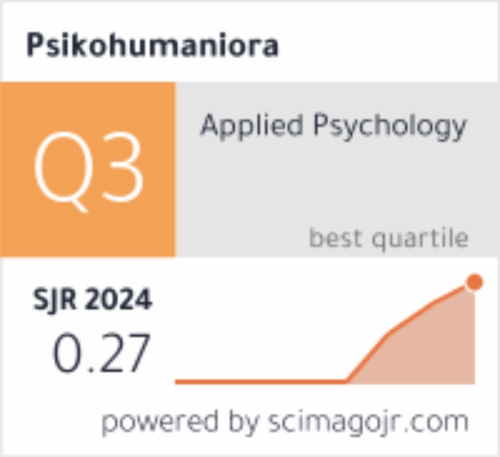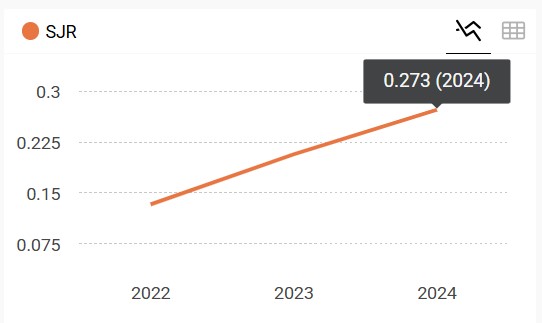Validation of happiness scale convergence in santri through Multi-trait Multi-method Analysis
DOI:
https://doi.org/10.21580/pjpp.v4i2.3670Keywords:
convergent validation, culture, happiness, religion, santriAbstract
Happiness is a concept that is difficult to understand to this date. Differences in individual perspectives in interpreting happiness also affect the processing construct of the measurement. This study aims to conduct convergent validation of the existing happiness scale. Convergent validation can test how good the happiness scale is by comparing the externally to another scale that is considered to have a relationship. The happiness convergent-scale validation adapted the Multi-trait Multi-method (MTMM) analysis. Respondents involved in this study were 186 students from traditional Muslim schools or Santri who were selected according to the specified characteristics and studied at UIN Sunan Gunung Djati Bandung. The three measuring instruments used are the Oxford Happiness Questionnaire (OHQ), the Indigenous Happiness Scale (IHS), and the World Health Organization Quality of Life-Bref (WHOQOL-Bref). The correlation coefficient (r) shows values of 0.52 (OHQ-IHS), 0.53 (OHQ-WHOQOL-Bref), and 0.45 (IHS-WHOQOL-Bref). The result indicated that the correlation of the three scales tested has a statistically high relationship so that the three measuring instruments used have convergent validity and can be used to measure the construct of happiness.
Downloads
References
Abde, A. N. Y., & Salih, K. (2015). The literature of happiness “with reference of the philosophy of happiness in Islam.” Journal of Islamic Studies and Culture, 3(2), 179–194. https://doi.org/10.15640/jisc.v3n2a18
Abdel-khalek, A. M., & Lester, D. (2010). Constructions of religiosity, subjective well-being, anxiety, and depression in two cultures: Kuwait and USA. International Journal of Social Psychiatry, 58(2), 138–145. https://doi.org/10.1177/0020764010387545
Akhtar, H. (2018). Perspektif kultural untuk pengembangan pengukuran kebahagiaan orang Jawa. Buletin Psikologi, 26(1), 54–63. https://doi.org/10.22146/buletinpsikologi.30895
Amalia, S. (2016). Analisa psikometrik alat ukur Ryff’s Psychological Well-Being (RPWB) versi bahasa Indonesia: Studi pada lansia guna mengukur kesejahteraan dan kebahagiaan. In Seminar Asean 2nd Psychology & Humanity (pp. 430–437). Psychology Forum UMM.
Anggoro, W. J., & Widhiarso, W. (2010). Konstruksi dan identifikasi properti psikometris instrumen pengukuran kebahagiaan berbasis pendekatan indigenous psychology: Studi multitrait‐multimethod. Psikologi, 37(2), 176–188. https://doi.org/10.22146/jpsi.7728
Anggraeni, R. D. (2011). Hubungan antara religiusitas dan stres dengan psychological well being pada remaja pondok pesantren. Jurnal Psikologi Teori Dan Terapan, 2(1), 29–45. https://doi.org/10.26740/jptt.v2n1.p29-45
Argyle, M. (2000). Psychology and religion: An introduction. London: Routledge.
Argyle, M., & Hills, P. (2002). The Oxford Happiness Questionnaire: A compact scale for the measurement of psychological well-being. Personality and Individual Differences, 33(7), 1073–1082. https://doi.org/10.1016/S0191-8869(01)00213-6
Azwar, S. (2012). Reliabilitas dan validitas (4th ed.). Yogyakarta: Pustaka Pelajar.
Azwar, S. (2017). Metode penelitian psikologi (2nd ed.). Yogyakarta: Pustaka Pelajar.
Campbell, D. T., & Fiske, D. W. (1959). Convergent and discriminant validation by the multitrait-multimethod matrix. Psychological Bulletin, 56(2), 81–105. https://doi.org/10.1037/h0046016
Carlson, K. D., & Herdman, A. O. (2012). Understanding the impact of convergent validity on research results. Organizational Research Methods, 15(1), 17–32. https://doi.org/10.1177/1094428110392383
Cronbach, L. J., & Meehl, P. E. (1955). Construct validity in psychological tests. Psychological Bulletin, 52(4), 281–302. https://doi.org/10.1037/h0040957
Dalai Lama. (2014). Happiness from a Buddhist perspective. Journal of Law and Religion, 29(1), 5–13. https://doi.org/10.1017/jlr.2013.13
Diener, E. (1984). Subjective well-being. Psychological Bulletin, 95(3), 542–575. https://doi.org/10.1037/0033-2909.95.3.542
Diener, E. (2006). Guidelines for national indicators of subjective well-being and ill-being. Journal of Happiness Studies, 7(4), 397–404. https://doi.org/10.1007/s10902-006-9000-y
Diener, E. F., & Suh, E. M. (Eds.). (2000). Culture and subjective well-being. Cambridge: The MIT Press.
Flake, J. K., Pek, J., & Hehman, E. (2017). Construct validation in social and personality research. Social Psychological and Personality Science, 8(4), 370–378. https://doi.org/10.1177/1948550617693063
Fornius, E. F., & Nyquist, H. (2009). Using the Canonical Design Space to Obtain c-optimal Designs for the Quadratic Logistic Model. Communications in Statistics - Theory and Methods, 39(1), 144–157. https://doi.org/10.1080/03610920802663307
Hossain, M. Z., Ahsan, M., & Rizvi, K. (2017). Relationship between religious belief and happiness in Oman : a statistical analysis. Mental Health, Religion & Culture, 0(0), 1–10. https://doi.org/10.1080/13674676.2017.1280009
Iedliany, F., Fahmie, A., & Kusrini, E. (2018). Pengembangan dan validasi instrumen pengukuran efektivitas tim di usaha mikro kecil dan menengah (UMKM). Psikohumaniora: Jurnal Penelitian Psikologi, 3(2), 177. https://doi.org/10.21580/pjpp.v3i2.3014
Jackson, D. N. (1969). Multimethod factor analysis in the evaluation of convergent and discriminant validity. Psychological Bulletin, 72(1), 30–49. https://doi.org/10.1037/h0027421
Jefferts Schori, K. (2014). The pursuit of happiness in the Christian tradition: Goal and journey. Journal of Law and Religion, 29(1), 57–66. https://doi.org/10.1017/jlr.2013.4
Joshanloo, M. (2013). A comparison of western and Islamic conceptions of happiness. Journal of Happiness Studies, 14(6), 1857–1874. https://doi.org/10.1007/s10902-012-9406-7
Joshanloo, M. (2014). Eastern conceptualizations of happiness: Fundamental differences with western views. Journal of Happiness Studies, 15, 475–493. https://doi.org/10.1007/s10902-013-9431-1
Kashdan, T. B. (2004). The assessment of subjective well-being (issues raised by the Oxford Happiness Questionnaire). Personality and Individual Differences, 36(5), 1225–1232. https://doi.org/10.1016/S0191-8869(03)00213-7
Lu, L., Gilmour, R., & Kao, S.-F. (2001). Cultural values and happiness: An east-west dialogue. The Journal of Social Psychology, 141(4), 477–493. https://doi.org/10.1080/00224540109600566
Lu, L., & Shih, J. Bin. (1997). Sources of happiness: A qualitative approach. The Journal of Social Psychology, 137(2), 181–187. https://doi.org/10.1080/00224549709595429
Mayasari, R. (2014). Religiusitas Islam dan Kebahagiaan (Sebuah Telaah dengan Perspektif Psikologi). Al-Munzir, 7(2), 81–100. https://doi.org/10.31332/AM.V7I2.281
Medvedev, O. N., & Landhuis, C. E. (2018). Exploring constructs of well-being , happiness and quality of life, 1–16. https://doi.org/10.7717/peerj.4903
Miskawaih, A. A. A. I. (1994). Menuju kesempurnaan ahlak. Bandung: Mizan.
Nasr, S. H. (2014). Happiness and the attainment of happiness: An Islamic perspective. Journal of Law and Religion, 29(1), 76–91. https://doi.org/10.1017/jlr.2013.18
Oishi, S., Graham, J., Kesebir, S., & Galinha, I. C. (2013). Concepts of happiness across time and cultures. Personality and Social Psychology Bulletin, 39(5), 559–577. https://doi.org/10.1177/0146167213480042
Pitts, R. T., & Naumenko, O. (2016). The 2014 standards for educational and psychological testing: What teachers initially need to know. Working Papers in Education, 2(1), 1–6.
Prakosa, H. (1995). Menetapkan validitas konvergen dan divergen dalam Matriks Multitrait-MulTimethod (MTMM). Buletin Psikologi, 3(2), 29–40. https://doi.org/10.22146/bpsi.13394
Purba, F. D., Hunfeld, J. A. M., Iskandarsyah, A., Fitriana, S., Sadarjoen, S. S., Passchier, J., & Busschbach, J. J. V. (2018). Quality of life of the Indonesian general population : Test-retest reliability and population norms of the EQ-5D-5L and, 1–20.
Rahmawati, E., Irmayanti Saragih, J., & Adeline, N. (2017). Psychometric properties of Indonesian version of the oxford happiness questionnaire. In Proceedings of the 1st Public Health International Conference (PHICo 2016) (Vol. 1, pp. 229–232). Paris, France: Atlantis Press. https://doi.org/10.2991/phico-16.2017.33
Ramdani, Z. (2018). Construction of academic integrity scale. International Journal of Research Studies in Psychology, 7(1), 87–97. https://doi.org/10.5861/ijrsp.2018.3003
Ramdani, Z., & Prakoso, B. H. (2019). Integritas akademik: Prediktor kesejahteraan siswa di sekolah. Indonesian Journal of Educational Assessment, 2(1), 29–40. https://doi.org/10.26499/
ijea.v2i1.14
Ramdani, Z., Supriyatin, T., & Susanti, S. (2018). Perumusan dan pengujian instrumen alat ukur kesabaran sebagai bentuk coping strategy. Jurnal Psikologi Islam Dan Budaya, 1(2), 97–106. https://doi.org/10.15575/jpib.v1i2.2955
Rizvi, M. A. K., & Hossain, M. Z. (2017). Relationship between religious belief and happiness: A systematic literature review. Journal of Religion and Health, 56(5), 1561–1582. https://doi.org/10.1007/s10943-016-0332-6
Ryff, C. D., & Keyes, C. L. M. (1995). The Structure of Psychological Well-Being Revisited, 69(4), 719–727.
Saadati, M. R., Amin, S. F., & Salimi, D. (2015). A study about place of happiness in Islam, 7(I), 159–164.
Salsabila, D. F., Rofifah, R., Natanael, Y., & Ramdani, Z. (2019). Uji validitas konstruk Indonesian-Psychological Measurement of Islamic Religiousness (I-PMIR). Jurnal Psikologi Islam Dan Budaya, 2(2), 1–10. https://doi.org/10.15575/jpib.v2i2.5494
Schmitt, N., Coyle, B. W., & Saari, B. B. (1977). A review and critique of analyses of multitrait-multimethod matrices. Multivariate Behavioral Research, 12(4), 447–478. https://doi.org/10.1207/s15327906mbr1204
Seligman, M. (2002). Authentic happiness: Using the new positive psychology to realize your potential for lasting fulfillment. New York: Free Press.
The WHOQOL Group. (1998). Development of the World Health Organization WHOQOL-BREF Quality of Life Assessment. Psychological Medicine, 28(3), 551–558. https://doi.org/10.1017/S0033291798006667
Uchida, Y., Norasakkunkit, V., & Kitayama, S. (2004). Cultural constructions of happiness: Theory and empirical evidence. Journal of Happiness Studies, 5(3), 223–239. https://doi.org/10.1007/s10902-004-8785-9
Veenhoven, R. (2001). Quality-of-life and happiness: Not quite the same. In G. DeGirolamo (Ed.), Salute e qualità dell vida (pp. 67–95). Torino: Centro Scientifico Editore.
Veenhoven, R. (2012). Cross-national differences in happiness : Cultural measurement bias or effect of culture? International Journal of Wellbeing, 2(4), 333–353. https://doi.org/10.5502/ijw.v2.i4.4
Widhiarso, W. (2008). Tanya jawab uji normalitas. Yogyakarta: Fakultas Psikologi UGM.
Downloads
Published
How to Cite
Issue
Section
License
The copyright of the accepted article shall be assigned to the publisher of the journal. The intended copyright includes the right to publish the article in various forms (including reprints). The journal maintains the publishing rights to published articles.
In line with the license, authors and any users (readers and other researchers) are allowed to share and adapt the material only for non-commercial purposes. In addition, the material must be given appropriate credit, provided with a link to the license, and indicated if changes were made. If authors remix, transform, or build upon the material, authors must distribute their contributions under the same license as the original.



